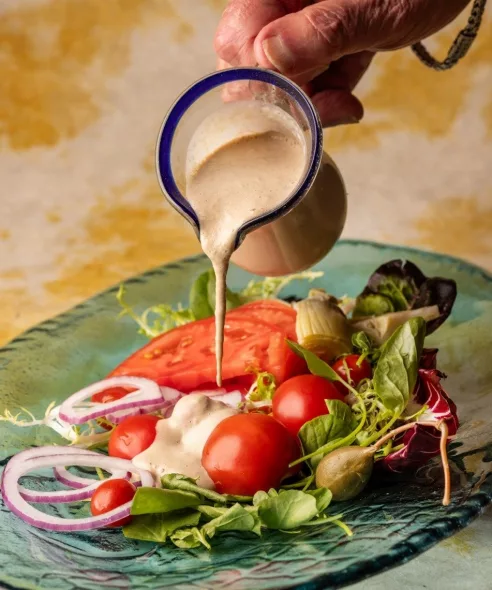The world of sauces is immense and includes hot and cold, savory and sweet. The word “sauce” comes from the Latin Salsus (salted) since salt has always been the basic condiment in cooking. The basic function of a sauce is to add a flavor that makes the dish more interesting and more appetizing with the other ingredients. Heaven forbid they sometimes are also used to cover up off flavors and, at its worst, spoiled foods.
The French are credited with the development of the sauce vocabulary generally and chef Marie-Antonie Careme was probably the most influential of the French chefs in this regard. Recognized as the founder of the French grande cuisine and a passionate sauce chef. He created what are known as the “Mother Sauces” of which there are 7:
– Hollandaise and its egg-butter variations such as Bernaise
– Esapagnole, essentially beef froth thickened with flour such as Bordelaise and Meurette
– Veloute, white broth thickened with flour
– Bechamel, Milk thickened with flour
– Mayonnaise, cold egg and oil such as Tartar and Aioli
– Tomato, such as Bolognese, Barbecue
– Beurre Blanc, butter thickened with cream and wine
There are of course a world of other sauces from many cuisines. At its simplest are American gravies, then Chutneys, Vinaigrettes, Salsas (uncooked), Soy and Miso based and more.
Many are given fanciful names. Explore! The use of the most common sauces is a great way to elevate your home cooking. For many chefs (especially those with a French background), a meal without a sauce is just not complete.
BALSAMIC GLAZE FOR FISHES AND MEATS
Makes a little less than 1/2 cup
This is a simple but very flavorful finisher to a simple grilled or pan seared fish or meat. It can be made well ahead of time and simply drizzled on the hot fish or meat at serving time.
1/2 cup balsamic vinegar
1/2 cup dry white wine
2 tablespoons fresh lemon juice
2 tablespoons brown sugar
1/8 teaspoon freshly ground black pepper (or to taste)
Add all ingredients to a small saucepan and bring to a boil. Cook over high heat until mixture thickens, about 3 – 4 minutes. Drizzle over almost anything!
CHIMICHURRI SAUCE
Makes 2 1/2 cups
There is no “best” chimichurri sauce. Much like Mexican salsas, you can find different interpretations in different regions of South America, particularly in Argentina and Uraguay. Chimichurri does not need to be an exact recipe—in fact, it’s actually better when it’s your recipe.
Traditionally, chimichurri is made by hand, not with a food processor. A food processor will create a sauce that’s a bit more of a blended paste, while mixing by hand results in a luscious condiment that drips off your food in rich, herbaceous slicks. It takes a bit more effort, but it’s well worth it.
1 small bunch flat leaf parsley
1 small bunch cilantro
¼ cup fresh oregano leaves
1 Tbsp. capers
1 small shallot, minced
4 large cloves of garlic, minced
1 small chili pepper, minced (optional)
2 Tbsp. sherry or red wine vinegar
2 Tbsp. lemon juice
⅔ cup flavorful olive oil
Salt and pepper, to taste
Trim the bottoms off the parsley and cilantro. Use a chef’s knife with a rocking motion to finely mince the herbs, stems and all. Add the oregano leaves and capers to the pile and mince into the rest of the herbs, then move them all to a mixing bowl.
Stir in shallot, garlic, chili (if using), vinegar, lemon juice, and olive oil. Add salt and pepper to taste, then allow to rest for at least 15 minutes, preferably longer. Taste again, and adjust with more salt/pepper/herbs/acid as you see fit. Chimichurri can be refrigerated in a glass jar or tightly sealed plastic container for up to three days.
ROMESCO SAUCE
Makes 2-1/2 cups
Romesco is a deeply flavored roasted sauce from the Catalonian region of Spain. It’s an amazingly versatile sauce that’s terrific served with everything from grilled vegetables and bread to shrimp, fish, chicken and steak.
4 dried Nora or ancho chiles (3/4 ounce), stemmed and seeded
4 sun-dried tomatoes
2 plum tomatoes
1/4 cup plus 2 tablespoons extra-virgin olive oil
Two 1/2-inch-thick slices of baguette
6 large garlic cloves, halved lengthwise
1/2 cup blanched almonds
1/4 cup blanched hazelnuts
1 roasted red bell pepper, seeded and chopped
1 teaspoon sweet paprika
2 tablespoons sherry vinegar
2 tablespoons minced parsley
Kosher salt
Pepper
In a medium saucepan, bring 1 1/2 cups of water to a boil. Remove from the heat and add the chiles and sun-dried tomatoes. Let stand until softened, about 1 hour. Drain, reserving the soaking liquid.
Meanwhile, roast the plum tomatoes directly over a flame or under the broiler until lightly charred in spots and the skin is blistered. Let cool, then peel and coarsely chop.
In a medium skillet, heat 1/4 cup of olive oil until almost smoking. Add the bread and garlic and cook over moderately high heat, turning occasionally, until browned all over, 2 to 3 minutes. Using tongs, transfer to a plate. Add the almonds and hazelnuts to the skillet and cook over moderate heat, stirring, until browned, about 3 minutes. Using a slotted spoon, transfer to the plate. Reserve the garlic oil.
In a food processor, pulse the bread, garlic and nuts until very finely chopped. Add the drained chiles and sun-dried tomatoes, the roasted tomatoes and bell pepper and the paprika, puree until smooth. With the machine on, gradually add the vinegar, 1/3 cup of the chile soaking liquid, 1 tablespoon of the garlic oil and the remaining 2 tablespoons of olive oil. Transfer to a medium bowl. Stir in the parsley and season generously with salt and pepper.
Romesco can be refrigerated for up to 4 days. Bring to room temperature before serving.
GINGER CREAM SAUCE
Makes about 1 cup
This is a wonderful all-purpose sauce for meats, fish and vegetables.
2 tablespoons finely chopped fresh ginger
1 tablespoon packed light brown sugar
1/4 cup sherry vinegar
1/3 cup dry white wine, stock or apple juice
3/4 cup heavy cream
Salt and freshly ground pepper
Fresh lemon juice
Add ginger, sugar, vinegar and wine to a small saucepan and heat to boiling. Add the cream and bring it back to the boil. Stirring often reduce to about 1 cup, 6 – 8 minutes. Strain through a fine-mesh strainer and season to your taste with salt, pepper and drops of lemon juice. Keep warm next to the stove.
GRAPEFRUIT SAUCE
Makes about 3/4 cup
This tart-sweet sauce is delicious with all kinds of grilled and roasted meat. Note the addition of the bit of fresh grapefruit juice at the end. This “brightens” the rich sauce and adds aromatics of the fruit that are lost when it’s cooked.
1-1/2 tablespoons balsamic vinegar
2 tablespoons sugar
2 cups rich chicken or duck stock
1 cup plus 1 tablespoon grapefruit juice
Salt and freshly ground pepper
Add the balsamic vinegar and sugar to a saucepan and cook over high heat until the sugar is melted and the mixture is reduced to a syrupy consistency, about 2 minutes. Add the stock and 1 cup of the grapefruit juice and reduce over high heat to 3/4 cup or so, 15 – 18 minutes. Whisk in the cream and continue to reduce until sauce is thickened, 3 – 4 minutes. Off heat, stir in remaining 1 tablespoon grapefruit juice, season to your taste with salt and pepper and keep warm. Can be made ahead and gently reheated.
BAGNA CAUDA
Makes about 1 cup
Literally “hot bath,” this dipping sauce for vegetables often appears in many Italian homes as part of the Christmas Eve buffet. It originated in Piedmont during the 16th century. Vegetable pieces are dipped into the sauce (a fondue-style fork will help) and then eaten, with a slice of bread held underneath to catch the drippings. Once the bread is soaked with sauce, it’s eaten, too. Then everyone starts over. Also delicious as a topping for grilled meats.
Kosher salt and freshly ground black pepper
3 tablespoons extra-virgin olive oil
2 tablespoons minced garlic (about 6 medium cloves)
2 tablespoons chopped anchovy fillets (about 8 fillets)
4 tablespoons unsalted butter, cubed
2 tablespoons fresh juice from 1 lemon
Chopped flat-leaf parsley, for garnish
In a heavy saucepan add olive oil. Over medium heat stir in garlic and anchovy and cook until garlic is lightly golden and anchovy has dissolved into the sauce, about 3 minutes. Stir in butter until melted. Stir in lemon juice and remove from heat. Serve warm.
SAUCE GRIBICHE
Makes about 1-1/3 cups
The roots of this sauce go back to the original Escoffier, creator of the bible of French cooking, first published in 1919. Delicious with fish no matter how you cook it
3 hard-boiled eggs, yolks and whites separated
1 tablespoon Dijon mustard
2 tablespoons chicken or vegetable stock
2 teaspoons lemon juice
1/2 cup olive oil
1 tablespoon drained capers, chopped
1 tablespoon small cornichon pickles or black olives, finely diced
1 tablespoon chopped mixed fresh herbs such as parsley, chives, tarragon, chervil, etc.
Salt and freshly ground pepper to taste
In a blender add the egg yolks, mustard, stock and lemon juice and puree till smooth. With the motor running, slowly add the oil to form a smooth sauce. Finely dice egg whites and stir into sauce along with remaining ingredients. Store chilled and covered in refrigerator for up to 2 days.

TUNA SAUCE FOR PASTA AND DIPPING
Makes approximately 2-1/2 cups
In Italy, this sauce is traditionally served with “Vitello Tonnato” a classic dish of cold braised veal which is sliced and garnished with this sauce along with oil cured olives, lemon slices and braised young vegetables. I think it’s also delicious both with pasta as well as a dipping sauce for raw crunchy vegetables. This makes enough to sauce up to 1-1/2 pounds of dry pasta. If you are concerned about raw egg yolk, you can use one that has been coddled or even hard cooked.
3/4 cup fragrant olive oil
1 teaspoon minced garlic
1 6-1/2 ounce can good tuna packed in oil
1 egg yolk
4 anchovy fillets, rinsed
3 tablespoons fresh lemon juice
1/3 cup heavy cream
1/3 cup or so rich chicken stock
3 tablespoons drained and chopped capers
1/3 cup minced flat leaf parsley
Salt and freshly ground white pepper
In a blender or food processor, add half the oil, garlic, tuna with its oil, egg yolk, anchovy and lemon juice and process briefly to puree. Place mixture in a small mixing bowl and stir in cream and stock gradually until sauce is of medium sauce consistency. Stir in capers and parsley and correct seasoning with salt and pepper. Toss with cooked pasta, either hot or cool.
John Ash © 2025

